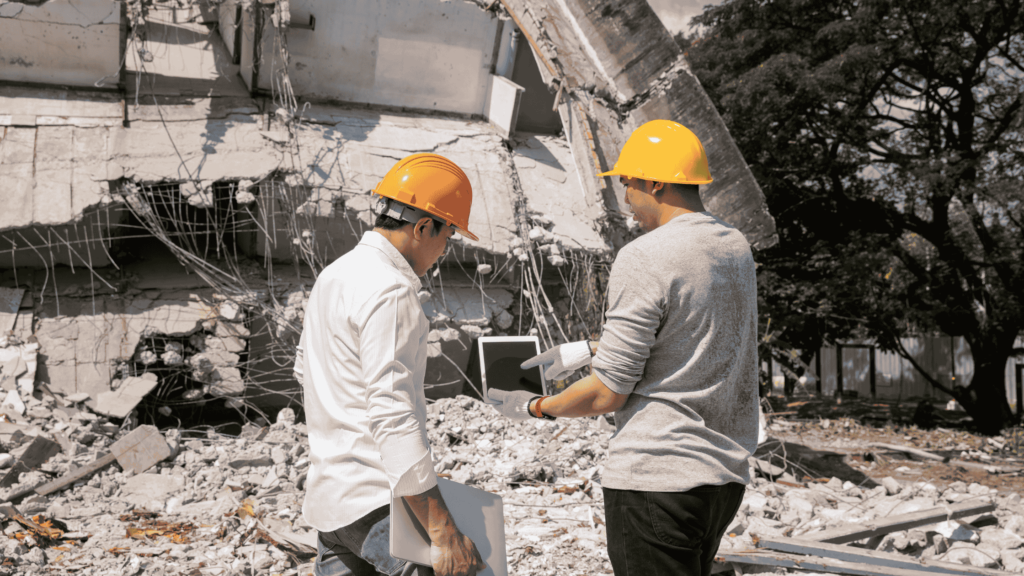In construction and renovation, demolition is the first step before rebuilding. This process breaks down parts of a structure, enabling safe and effective renovation. Understanding the difference between interior demolition and full demolition is crucial, as each serves a different purpose.
Interior demolition targets non-structural elements, ideal for kitchen or office remodels, while full demolition involves removing the entire building, including structural elements. Choosing the right demolition approach can help avoid extra costs, delays, and ensure safety.
Table of Contents
ToggleWhat is Interior Demolition?
Interior demolition focuses on removing non-structural elements like walls, flooring, drywall, and plumbing, while preserving the main structure. Unlike full demolition, it targets specific areas for renovation, such as kitchens, bathrooms, or offices. This process requires careful planning to avoid damage to essential systems.
Interior demolition is often more cost-effective than total demolition since the structure remains intact. It allows for small upgrades or larger remodels without starting from scratch. Additionally, it helps address specific issues like redesigning spaces or removing water-damaged materials, saving on unnecessary expenses.
What is Full Demolition?
Full demolition—sometimes referred to as total demolition—involves the complete removal of an entire building. Unlike selective demolition or the interior demolition process, this type of demolition clears away all structural elements, including foundations, framing, and load bearing walls, leaving nothing behind. In most cases, the process involves tearing down everything so that a new construction project can begin on a clean slate.
This approach is typically required when a structure is unsafe, has experienced severe water damage, or when property owners want to start entirely from scratch. For example, older houses that are beyond repair or commercial spaces that need a fresh footprint often rely on this method. Such demolition projects require careful planning, coordination with a licensed demolition contractor, and strict adherence to safety regulations.
The benefits of full demolition are significant. First, it allows for maximum design freedom since the site is completely cleared for new renovation projects or brand-new builds. Second, it offers flexibility for long term planning—developers and homeowners alike can create layouts without being limited by existing walls or outdated structures. Finally, while full demolition is generally more expensive than interior removal, it can still be cost effective in cases where repairing or reusing old materials would exceed the cost of starting over.
Key Differences: Interior vs Full Demolition
When comparing interior demolition to full or total demolition, the differences are clear. Each type of demolition serves a unique purpose, and understanding these contrasts helps property owners choose the right method for their demolition projects or renovation projects.
1. Scope of Work
Interior demolition focuses on removing non-structural parts of a building—such as drywall, flooring, and ceilings—without disturbing the main structural elements. The interior demolition process may also include removing outdated systems or finishes while leaving load bearing walls intact. On the other hand, full demolition involves the complete removal of an entire structure, including foundations and framework. This process involves tearing down everything, often leaving only a cleared site.
2. Cost Considerations
Interior demolition is often more cost effective because it preserves much of the building’s structure. It allows owners to invest in upgrades rather than rebuilding entirely. Full demolition, however, may be more expensive upfront but can save money in the long term if a property has significant issues such as severe water damage or unsafe structures that would cost more to repair than to rebuild.
3. Timeframe
Selective demolition and interior projects are generally quicker since only portions of the property are removed. Full demolition typically takes longer, as it requires careful planning, heavy equipment, and complete site clearance.
4. Permits & Regulations
Both interior demolition and total demolition require permits, but the level of approval varies. Full demolition usually demands stricter compliance because it demolition involves removing all structural elements and clearing the site. Interior work still needs authorization, but regulations are often simpler since the building remains structurally sound.
5. Safety Measures
Safety is critical for both methods. Interior projects must be handled with care to avoid damaging key load bearing walls or hidden utilities, while full demolition demands comprehensive site safety, debris control, and proper waste management. A professional demolition contractor can plan and execute either method safely, ensuring compliance with local regulations and protecting workers as well as surrounding properties.
Choosing the Right Option
Selecting between interior demolition and total demolition depends on several important factors, including your budget, overall project goals, and the current condition of the building. Each type of demolition comes with its own requirements, benefits, and risks, so making the right choice requires careful planning.
Factors to Consider
- Budget: If you are working within a tighter budget, interior demolition is often more cost effective because it preserves the structure and limits removal to non-essential parts. Full demolition, by contrast, can be more expensive upfront since it involves the complete teardown of a building.
- Project Goals: For renovation projects, interior demolition focuses on reconfiguring space without disturbing major structural elements or load bearing walls. However, when the vision requires a fresh start—such as a new layout, additional stories, or large-scale development—total demolition may be the better option.
- Building Condition: If the property has severe water damage, outdated systems, or compromised structural elements, a demolition contractor may recommend starting over. In these cases, full demolition can be more practical in the long term.
Examples of When to Choose
- Interior Demolition: Ideal for kitchen remodels, office redesigns, or retail space updates where the structure remains solid. The interior demolition process allows you to keep the building intact while still upgrading functionality and style.
- Full Demolition: Best when the entire property is unsafe, beyond repair, or when demolition involves clearing land for brand-new development. This process involves removing every component of the existing structure to give you a clean foundation for new construction.
In both cases, the work should be handled by an experienced demolition contractor who can plan and execute the job while ensuring safe procedures and proper waste management. Whether you need selective demolition for a small remodel or full clearance for a redevelopment project, expert guidance makes the difference.
If you’re unsure which method fits your needs, contact us today for professional advice on how to move forward with your demolition projects.
Professional Help & Safety
Demolition is never a task to take lightly. Whether it’s selective demolition, the interior demolition process, or total demolition that involves the complete teardown of a structure, every type of demolition must be handled by professionals. Hiring a licensed demolition contractor ensures that the project is performed safely, legally, and efficiently.
Why Hire Licensed Demolition Contractors
A qualified contractor like ThefixitGuys understands how to plan and execute complex demolition projects. Interior jobs may seem simple, but even when interior demolition focuses on non-structural areas, hidden load bearing walls or vital structural elements can pose risks if not handled properly.
Full demolition is even more demanding, as the process involves heavy machinery, permits, and coordination with local authorities. Licensed contractors also know how to identify problems such as water damage, asbestos, or unstable foundations that could complicate the work.
Importance of Safety, Permits, and Waste Disposal
Demolition is not just about breaking down walls—it also requires careful planning to protect workers, neighbors, and the property itself. Proper permits are legally required for both renovation projects and complete teardowns, and failing to secure them can result in costly delays or penalties. Additionally, demolition involves managing debris, dust, and hazardous materials, which makes responsible waste management critical.
A professional approach is not only safer but often more cost effective in the long term, as it minimizes mistakes and ensures compliance with local regulations. Whether your project calls for small-scale selective demolition or a large-scale total demolition, the right contractor ensures that everything is done correctly from start to finish.
For expert guidance and safe execution of your next project, contact us today to discuss the best path forward for your demolition projects.
Conclusion
Both interior demolition and total demolition play important roles in construction and renovation projects. The key difference is that interior demolition focuses on removing non-structural areas while preserving load bearing walls and other vital structural elements, whereas full demolition involves the complete removal of a structure. One type of demolition may be more cost effective for small-scale updates, while the other provides a clean slate for long term redevelopment.
Remember, each option requires careful planning. The interior demolition process is ideal for targeted remodels, while selective demolition helps address specific concerns like water damage. In contrast, full teardown demolition projects are often necessary when a building is unsafe or outdated. Regardless of the approach, every project demolition involves strict safety measures, responsible waste management, and guidance from a licensed demolition contractor who can plan and execute the job properly.
If you’re unsure which method is right for your property, don’t leave it to guesswork. For professional advice, safe execution, and reliable results, contact us today and consult with a trusted demolition expert to find the best solution for your project.




























